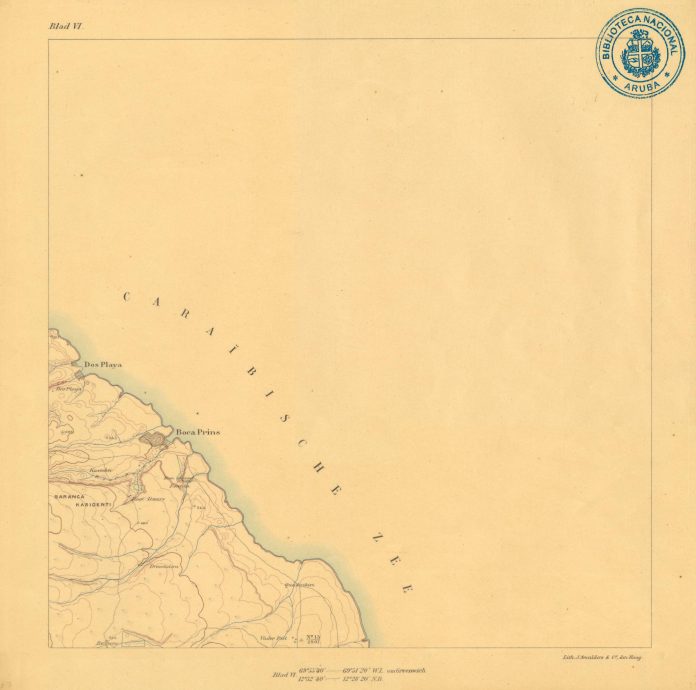(Oranjestad)—Most folkloric tales and legends in Aruba revolve around our indigenous ancestors, who came from mainland Venezuela, and discovered the island and made it into their new home. This particular legend tells the story of the birth of the Aruba name.
The legend follows the life of Arua, an indigenous Cacique originally from Aroa in the Falcon state in Venezuela in the year 50 AD. Arua had a son around the year 70 AD with his wife Shira, who they named Corobori. When Corobori was old enough, he joined his father on the usual boat trip to the islands of Curacao and Bonaire to gather salt.
On their way back to Mainland Venezuela, they were caught up in a heavy rain storm—a side effect from a passing, but far away, hurricane. Of course, because of the lack of motors and sail, their boat was left in the mercy of the heavy winds. After a while, the storm started to pass, and the clouds began to clear up. Finally able to see around them, the Cacique spotted land approximately an hour away. So, they started to row in that direction until they reached the coast.
Once they arrived on what they thought was Venezuela, they decided to stay the night and fix their kayak. The next morning, the Cacique ordered his son and a few warriors to go find any sign of population in the area: “Corobori,” Arua said. “Don’t come back without news. It’s in your hands how long we stay here till we find our family. So, if you need to take a week to gather information, we will wait for you.”
“Don’t worry,” Corobori replied. “As soon as we have any information, we will let you know.” Armed with arrows and spears, backpacks filled with food and water containers, they set off. They climbed several small hills, but no sign of a village. They crossed different dry riverbeds, but no sign of anything. When the sun finally descended, they found themselves near a fairly tall hill and decided to climb it for a better view of a village. This hill was called Pan Dushi or Orcuyo, which today we call Hooiberg.
The next morning, they could clearly see that they have landed on an island, but an unfamiliar one at that. When Corobori went back to where his father was waiting, he told him the news: “Father Arua, you have just discovered an island, but it is not Curacao or Bonaire. Far in the south, we saw the big mountains of our homeland Venezuela, which we could have never seen on the other island. This leads us to believe we are on a new island. But that’s not all. When the sun came up, we saw in the distance a glowing plain, which we think may be salt.”
The Cacique was pleased to hear of his son’s findings. He decided to stay a couple days on the newly-discovered island in search for salt. The next morning they ascended Hooiberg again and stayed to see if they could find nearby smoke, indicating an inhabitant village. But they found nothing. So they went back to their initial arrival settlement, now known as Santo Largo in Savaneta. The next morning they hiked along the Spaans Lagoen near the Mangel Halto Beach and reached the area of Bushiri. There, they boarded they kayaks and heading to what we know now as Malmok, where they found rocks of salt. After a couple days of exploring the island and gathering some salt rocks, they left for Venezuela, where they were reunited with their families.
Throughout the year, they travelled back and forth to Aruba, collecting salt. After a while they settled on the island, generations of families living along the coast. Corobori was the first indigenous inhabitant in our history to explore the entirety of the island.
Arua, after decades as the leader of his tribe, spent his last days on the island. Having reached 80 years old, he called for his family on his death bed. In his hammock, he said: “My children, many years have passed, and I’ve asked my warrior to bring me back to the island so I can laid to rest. The God of living has given me the gift of life to see my son, grandchildren and great grandchildren. But now he is calling me home. Corobori, my torch is now passed to you. Guide our people, and be the leader you were always meant to become. If one day you leave my island, do not forget that it is also yours. This is my last wish: When I die, bury me in our maize plantation.”
And so when the Cacique passed away, his wishes were granted and he was laid to rest in the area we now know as the Paradera Cemetery. Where he used to live, they built the Paradera Church.
And that is the tale of what inspired the Aruba name. In the generations that lived or travelled back and forth to the island, there were many familiar names*, like Guadiriki, a warrior who was there when the island got discovered and his son, whom he called Huliba; Corobori and his children, Corodori, Camacuri and Turibana, Masiduri; and Malmok, the 13-year-old boy who alerted the Cacique when the Caribes attacked.
Familiar names: all these names are familiar to Arubans, as these are the names of places and plants on the island.
Source: Un storia di e Indjan Arua (A story of the Indian Arua) by Adolf (Dufi) Kock

















